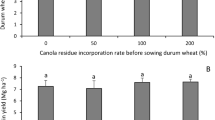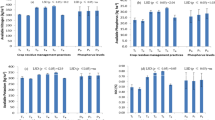Summary
In a 3 year field study, the effect of two rotations, paddy (Oryza sativa L.), wheat (Triticum aestivum L.), mung (Phaseolus aureus L.) and corn (Zea mays L.), wheat (Triticum aestivum L.), mung (Phaseolus aureus L.) on wheat yield and chemical, physical and biological properties of soil was evaluated. Grain yield of the wheat sown after paddy during 1972–73, 1973–74 and 1974–75 was lesser by 0,300 and 390 kg/ha respectively than that of the wheat following corn. The reduction in the yield of wheat was attributed to relatively higher NPK removal by paddy, greater immobilization of N applied to wheat and deterioration of soil physical conditions in the paddy field. Total NPK removal by paddy average 131 kg/ha more than that by corn. Sharp increase in bacterial population of soil during early growth of wheat that followed paddy and the concurrent less available N in soil and low N content in wheat plants suggested that the N applied to wheat was immobilised to organic form. The increase in soil bulk density and particle dispersion ratio and decrease in water storage in deeper soil layers in the paddy field probably restricted the root proliferation and growth of wheat.
Similar content being viewed by others
Literature Cited
Alexander, M. 1965 Introduction to Soil Microbiology. John Wiley and Sons, New York.
Bertrand, A. R. 1965 Rate of water intake in the field.In C. A. Black (Ed.) Methods of Soil Analysis. Part I. Physical and Minerological properties, including statistics of Measurement and Sampling. Agronomy Monograph No.9, 197–201. Am. Soc. Agron., Madison, Wis.
Black, C. A. 1965 Method of Soil Analysis. Part 2, Chemical and Microbiological properties. Agronomy Monograph No.9, Am. Soc. Agron., Madison, Wis.
Chaudhary, T. N. and Gildyal, B. P. 1969 Aggregate stability to puddled soil during rice growth. J. Indian Soil Sci.17, 261–265.
Clark, F. E. 1969 Agar plate method for total microbial count.In C. A. Black (Ed.) Methods of Soil Analysis. Part 2. Chemical and Microbiological properties. Agronomy Monograph No.9, 1460–1466.
Jackson, M. L. 1967 Soil Chemical Analysis. Asia publishing House, New Delhi.
Middleton, H. F. 1930 Properties of soils which influence erosion, U.S.D.A. Tech. Bull.178, Adv. Agron.12, 311–363.
Prihar, S. S. and Hundal, S. S. 1971 Determination of bulk density of soil clod by saturation. Geoderma5, 283–286.
Richard, L. A. 1953 Modulus of rupture as an index of crusting soil. Soil Sci. Soc. Am. Proc.17, 321–323.
Sehgal, J. L. and Sys, C. 1970 The soils of Punjab, India, III. Classification and geographic distribution. Pedologie20, 357–380.
Subbiah, B. V. and Asija, G. L. 1956 A rapid method for the estimation of available nitrogen in soils. Curr. Sci.25, 259–260.
Yoder, R. E. 1936 A direct method of aggregate analysis and a study of tropical nature of erosion losses. J. Am. Soc. Agron.28, 337–351.
Author information
Authors and Affiliations
Rights and permissions
About this article
Cite this article
Meelu, O.P., Beri, V., Sharma, K.N. et al. Influence of paddy and corn in different rotations on wheat yield, nutrient removal and soil properties. Plant Soil 51, 51–57 (1979). https://doi.org/10.1007/BF02205926
Received:
Revised:
Issue Date:
DOI: https://doi.org/10.1007/BF02205926




